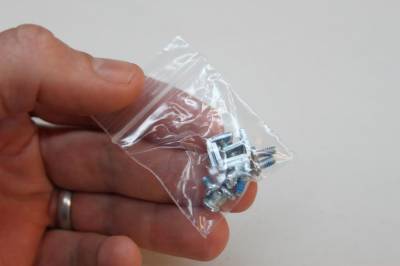Pixy2 Quick Links
Basics
Connecting Pixy2 to…
Pixy2 Modes / Programs
Software and Support
Basics
Connecting Pixy2 to…
Pixy2 Modes / Programs
Software and Support
Pixy2 was designed to befriend your robot or any other device you've dreamed up. So, with each Pixy2 we include brackets and fasteners to make mounting Pixy2 to your device fairly simple.
Here's what you'll need:
Your Pixy2 (Pixy1 shown here – just pretend it's a Pixy2 ![]() )
)

The bag of fasteners that came with your Pixy2

Before we continue, take all four right-angle brackets out of the little baggie and examine them. Notice that two of them have two threaded holes and two of them have one threaded hole. We'll call these two-threaded and one-threaded brackets, respectively. Go ahead and separate these two bracket types to make things easier.
Notice also that the baggie contains two different types of fasteners, three longer fasteners and five shorter fasteners. All of them are the same 4-40 thread.
The simplest way to mount Pixy2 is at a right angle, which is usually all that's required. Take two of the shorter 4-40 fasteners and two of the two-threaded brackets (or one-threaded brackets if you wish) and attach to Pixy2 as shown.
But first, a word about the two-threaded brackets. If you look really closely at one of these guys, you'll notice that one of its legs is ever-so-slightly longer than the other. Say what? It's true— I don't know why. But you can best see this by looking at the holes in the bracket. One of the holes in centered in its leg and the other hole is not centered, because its leg is slightly longer. Weird. Just make sure that when you use the two-threaded bracket you keep this in mind, otherwise your Pixy2 might look a little crooked after you finish mounting. Just a heads-up, to prevent some possible confusion.
Back mount
Front mount
You can then mount Pixy2 by drilling some holes into your device and using the supplied 4-40 fasteners (long or short). Or you can use self-tapping fasteners (wood or sheet-metal fasteners) and the one-threaded brackets to attach Pixy2 to your device.
Sometimes you want to be able to adjust the tilt angle of your sensor so it's looking where you want it to look (down or up). You can do this with a motorized tilt, using a similar mechanism to the pan-tilt. Or you can use a fixed, but adjustable tilt pivot mount, which is what we'll describe now.
Start by attaching the one-threaded brackets to Pixy2 with the shorter 4-40 fasteners as shown in the picture.
Then attach the two-threaded brackets with two more shorter 4-40 fasteners. Refer to the picture below.
You can then mount Pixy2 by drilling some holes into your device and using the long 4-40 fasteners. Or you can use self-tapping fasteners that will fit though the holes in the bracket.
Choose the tilt angle you like best and tighten the fasteners tight. Readjust by loosening/re-tightening.